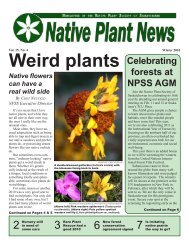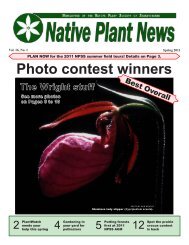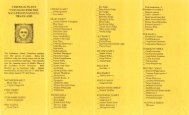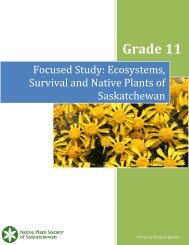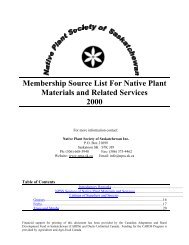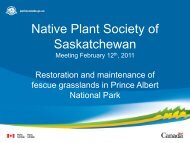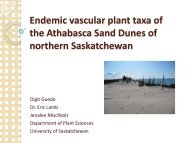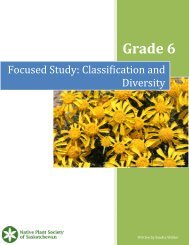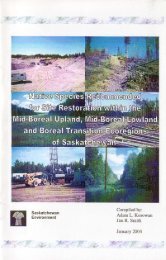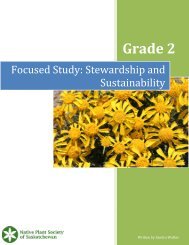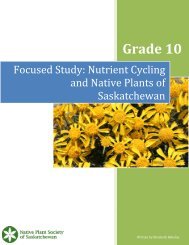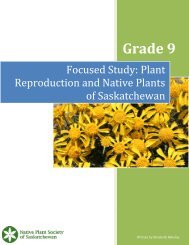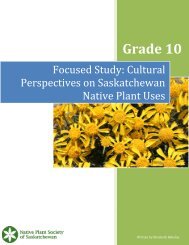Guidelines for Rare Plant Surveys - Native Plant Society of ...
Guidelines for Rare Plant Surveys - Native Plant Society of ...
Guidelines for Rare Plant Surveys - Native Plant Society of ...
Create successful ePaper yourself
Turn your PDF publications into a flip-book with our unique Google optimized e-Paper software.
<strong>Guidelines</strong> <strong>for</strong> <strong>Rare</strong> <strong>Plant</strong> <strong>Surveys</strong><br />
Edited by Diana Bizecki Robson<br />
INTRODUCTION<br />
With the recent protection <strong>of</strong> some <strong>of</strong> Saskatchewan’s rare plants under The Wildlife Act,<br />
industry will be required to conduct rare plants surveys as part <strong>of</strong> Environmental<br />
Protection Plans and Environmental Impact Assessments. However, there are currently<br />
no guidelines <strong>for</strong> surveys put <strong>for</strong>th by the Saskatchewan government. The absence <strong>of</strong><br />
standards has resulted in variable quality surveys and little consistency in reporting rare<br />
plant occurrences in the province. The <strong>Native</strong> <strong>Plant</strong> <strong>Society</strong> <strong>of</strong> Saskatchewan has<br />
developed guidelines <strong>for</strong> rare plant surveys in the interest <strong>of</strong> identifying and protecting<br />
sensitive species, and in setting standards <strong>for</strong> industry.<br />
These guidelines are intended <strong>for</strong> industry environmental co-ordinators, so they can better<br />
evaluate proposals and rare plant surveyor qualifications, <strong>for</strong> consultants so that they are<br />
aware <strong>of</strong> acceptable procedures and <strong>for</strong> the government so they can better evaluate the<br />
quality <strong>of</strong> rare plant survey reports.<br />
<strong>Rare</strong> plant survey guidelines were produced <strong>for</strong> the Cali<strong>for</strong>nia <strong>Native</strong> <strong>Plant</strong> <strong>Society</strong> by<br />
James Nelson (1987), and <strong>for</strong> the Alberta <strong>Native</strong> <strong>Plant</strong> Council by Jane Lancaster (1998).<br />
These guidelines were used as a template <strong>for</strong> the Saskatchewan guidelines.<br />
RARE PLANTS AND BOTANICALLY SIGNIFIGANT ASSEMBLAGES<br />
A rare plant species is any native species that, because <strong>of</strong> its biological characteristics or<br />
because it occurs at the fringe <strong>of</strong> its range, or <strong>for</strong> some other reason, exists in low<br />
numbers or in very restricted areas in Saskatchewan or in Canada.<br />
<strong>Rare</strong> plant species that must be tracked during a survey are those plants on the<br />
Saskatchewan Conservation Data Centre’s (SCDC) tracking list (1996). Those plants<br />
considered nationally rare by the Committee on the Status <strong>of</strong> Endangered Wildlife in<br />
Canada (COSEWIC) or the Canadian Museum <strong>of</strong> Nature (Argus & Pryer, 1990), or<br />
protected by Saskatchewan’s Wildlife Act are particularly important to note. The status<br />
<strong>of</strong> a rare species may change as new in<strong>for</strong>mation becomes available, so it is important to<br />
receive regular status updates from the appropriate organizations. Any plant that has not<br />
previously been found in the province–provided it is not an exotic species–would also be<br />
considered rare and should be carefully documented.<br />
Botanically significant assemblages may include rare native plant communities like<br />
fescue grassland, or diverse, representative, undisturbed, endemic, disjunct or unusual<br />
communities <strong>of</strong> plants. The SCDC’s database contains some in<strong>for</strong>mation on rare plant
communities and will mention them when a rare plant search is per<strong>for</strong>med. Whether other<br />
plant assemblages are considered unique or not is left to the judgment <strong>of</strong> the surveyor.<br />
QUALIFICATIONS OF SURVEYORS<br />
Deciding if a person has the qualifications necessary to conduct rare plant survey work<br />
can be difficult due to the variety <strong>of</strong> experience that people have. An examination <strong>of</strong><br />
resumes as well copies <strong>of</strong> previous rare plant survey reports will help one assess the<br />
qualifications <strong>of</strong> rare plant surveyors and the quality <strong>of</strong> their work. In general, a rare plant<br />
surveyor should have:<br />
* experience as a botanical field investigator;<br />
* taxonomic experience and a knowledge <strong>of</strong> plant ecology (the surveyor should have<br />
some college coursework in plant taxonomy and ecology, and preferably be<br />
recommended by another pr<strong>of</strong>essional botanist);<br />
* familiarity with the local flora and potential rare plants in the habitats to be surveyed;<br />
* familiarity with provincial and federal laws, and Saskatchewan Environment and<br />
Resource Management policies and regulations that pertain to rare plant protection and<br />
environmental assessment;<br />
* a demonstrated ability to prepare detailed technical reports.<br />
OBJECTIVES OF A RARE PLANT SURVEY<br />
<strong>Rare</strong> plant surveys are undertaken to determine the presence and location <strong>of</strong> rare plant<br />
species and rare vegetation communities over areas proposed <strong>for</strong> development.<br />
Documentation <strong>of</strong> rare plant survey results and population data are required <strong>for</strong><br />
government assessment <strong>of</strong> potential project impacts. Due to possible rare plant dormancy,<br />
a rare plant survey can only confirm the presence <strong>of</strong> rare plants on a site, not deny it.<br />
However, the more <strong>of</strong>ten an area is surveyed without finding a rare plant population, the<br />
lower the likelihood that a dormant population is present.<br />
RARE PLANT SURVEY PROCEDURE<br />
1.Review project proposal<br />
In order to plan field work, conduct database searches and provide mitigative options, the<br />
surveyor should be familiar with various aspects <strong>of</strong> the project including the precise<br />
location, size and type <strong>of</strong> the disturbance, and location flexibility.<br />
2. Collect in<strong>for</strong>mation on potential rare plants
Obtain previous rare plant records <strong>for</strong> the project area by contacting the SCDC and the<br />
W.P. Fraser Herbarium. Conducting searches <strong>of</strong> the rare plant databases at both the<br />
SCDC and W.P. Fraser Herbarium is necessary since one may have in<strong>for</strong>mation that the<br />
other doesn’t. For example, the SCDC database may have rare plant sightings on record<br />
without a corresponding voucher specimen. In turn, the Herbarium may have a rare plant<br />
sighting in their database that has not yet been downloaded into the SCDC database (this<br />
is done every few months). Known occurrences <strong>of</strong> rare plants should be mapped onto<br />
topographic maps or air photos and taken into the field.<br />
Also assess the likelihood <strong>of</strong> other rare plants appearing in the study area; the lack <strong>of</strong><br />
database in<strong>for</strong>mation could simply mean that no one has visited the area be<strong>for</strong>e. Potential<br />
rare species include those found in nearby areas and those found in similar habitats.<br />
Check floras, distribution maps, published reports and existing species lists <strong>for</strong> the area to<br />
help with the composition <strong>of</strong> a list <strong>of</strong> potential rare species.<br />
Collecting in<strong>for</strong>mation on potential rare plants is not a substitute <strong>for</strong> a survey. Database<br />
in<strong>for</strong>mation is incomplete and rare plants are not always predictable in where they occur.<br />
3. Study unfamiliar rare plants<br />
Surveyors should familiarize themselves with herbarium specimens <strong>of</strong> potential rare<br />
species. Key characters useful in differentiating rare species from similar common<br />
species should be noted. Data from herbarium labels can be useful <strong>for</strong> determining likely<br />
habitat, flowering dates (and thus the best time <strong>for</strong> the survey) and associated species.<br />
Determine when to conduct the survey<br />
Determine when potential rare plants at the site will be easiest to identify (i.e. flowering<br />
stage), and when the plants reach that stage <strong>of</strong> maturity. By determining the best time to<br />
identify potential rare plants, the best time(s) to conduct the survey(s) will become<br />
apparent. Several visits may be required in one season to adequately survey <strong>for</strong> all rare<br />
plants.<br />
Ideally, sites should be assessed over a number <strong>of</strong> growing seasons and moisture<br />
conditions <strong>for</strong> several reasons. First <strong>of</strong> all, many plants will not produce flowers during<br />
certain climatic conditions (i.e. very moist or dry years) making them difficult to spot and<br />
identify. Second, in a number <strong>of</strong> plant families with subterranean perennial organs<br />
(corms, bulbs, tubers etc.), above ground growth can be absent during the growing season<br />
<strong>for</strong> 1-2 years (and occasionally longer); typically this dormancy occurs in 25% or less <strong>of</strong><br />
the population at one time (Lesica and Steele, 1994). Lastly, factors such as grazing and<br />
insects can affect the vigor and visibility <strong>of</strong> rare plants on a site.<br />
Depending on the type and urgency <strong>of</strong> the project, only one survey may be feasible. If<br />
only a single rare plant survey can be per<strong>for</strong>med, the best time to do it is in mid-late
summer. Early blooming rare plants will be in a seed stage and still potentially<br />
identifiable and later blooming species will probably be flowering.<br />
Determine where to survey<br />
During the survey, each representative plant community should be examined thoroughly.<br />
Over areas about a section in size (640 acres or 259 hectares), visiting all plant<br />
communities in a day should be possible except in very dense bush or treacherous terrain.<br />
Detailed surveys <strong>of</strong> areas slightly larger than this will take two to several days. Over very<br />
large areas the search should concentrate on as many likely habitats as is feasible.<br />
Examination <strong>of</strong> air photos and topographical maps may aid in the identification <strong>of</strong> likely<br />
rare plant habitats (i.e. active sand dunes, vernal pools/depressions etc.). However, since<br />
some rare plants will appear in habitats where you never expected to find them, every<br />
plant community type in the study area should be visited at least once. It may be useful to<br />
map the vegetation communities over large areas prior to conducting the survey to<br />
determine where to target field work. Mapping would help ensure that each major plant<br />
community type is examined.<br />
6. Conduct the survey<br />
A floristic survey technique should be used rather than quantitative vegetation sampling.<br />
Quantitative analysis techniques are inappropriate <strong>for</strong> rare plant surveys as they tend to<br />
over-represent dominant species and cover only small portions <strong>of</strong> an area. However, it is<br />
important to have a general community description to place any rare species found within<br />
a community context. Floristic techniques involve the identification <strong>of</strong> all plant species<br />
encountered to a taxonomic level where their rarity can be determined. For example,<br />
identifying a plant to genus (not species) may be adequate if that genus has no rare plants<br />
in it. Some rare plants are subspecies, so identifying only to species level would not be<br />
adequate in some situations. The names <strong>of</strong> the plants encountered should be recorded on<br />
a data sheet. A specimen <strong>of</strong> any unknown plants should be collected <strong>for</strong> later<br />
identification in a laboratory.<br />
Systematic survey search patterns are recommended to minimize overlap and maximize<br />
coverage. Search patterns will depend on the topography and vegetation cover. Where<br />
conditions permit, walking a series <strong>of</strong> roughly parallel transects in a search unit will<br />
maximize coverage <strong>of</strong> the area. Spacing <strong>of</strong> the search transects will depend on the density<br />
<strong>of</strong> the vegetation cover, visibility through it, and the size <strong>of</strong> the plants in it.<br />
7. Document rare plant sightings<br />
The documentation <strong>of</strong> a rare plant population is the most important step in a survey. The<br />
client needs to know the precise location <strong>for</strong> mitigation planning, the SCDC needs the<br />
data to make rarity status decisions and the Herbarium needs the data to increase our<br />
scientific understanding <strong>of</strong> rare plants. Documentation can consist <strong>of</strong>:
* A voucher specimen and a rare plant occurrence <strong>for</strong>m;<br />
* Several photographs, a detailed description <strong>of</strong> the morphological characteristics and a<br />
rare plant occurrence <strong>for</strong>m.<br />
A voucher specimen should not be collected unless the local rare plant population has<br />
more than 20 individuals and the specimen will be donated to a Herbarium. Even then,<br />
the voucher should consist <strong>of</strong> only enough <strong>of</strong> the plant to confirm its identity (i.e. a single<br />
branch with several leaves and a few flowers and/or fruits). However, in certain plant<br />
families (i.e. mustards, adder’s tongue) collecting a single branch may result in the<br />
collection <strong>of</strong> the entire above ground portion <strong>of</strong> the plant. In this case, an ef<strong>for</strong>t should be<br />
made to leave the root system intact. If an annual plant has only one branch, it should<br />
only be picked after most <strong>of</strong> the seeds (i.e. 90%) have fallen <strong>of</strong>f the plant, if it is possible<br />
to identify it in this stage.<br />
Photographs should be taken <strong>of</strong> the habitat, life <strong>for</strong>m and diagnostic features (i.e. closeups<br />
<strong>of</strong> the flowers or fruits) <strong>of</strong> a rare plant to help with relocation and identification <strong>of</strong> the<br />
plant(s). Photographs can be a substitute <strong>for</strong> a voucher specimen. However, if a voucher<br />
specimen will not be collected, measurements <strong>of</strong> leaf, flower and/or fruit width and<br />
length, and overall plant height should be recorded. Colour, shape and vestiture <strong>of</strong> the<br />
stems, leaves and reproductive structures, and type <strong>of</strong> inflorescence should also be<br />
recorded. The references used to key the plant out should be stated.<br />
To ensure proper identification <strong>of</strong> rare species, a taxonomic expert should review all<br />
specimens and photographs/descriptions.<br />
A rare plant occurrence <strong>for</strong>m should be filled out whenever a rare plant population is<br />
encountered. This <strong>for</strong>m includes spaces to record documentation in<strong>for</strong>mation and<br />
location, habitat, population and collector data. A good Global Positioning System (GPS)<br />
can record very accurate location data although location can also be ascertained using<br />
maps or air photos. Required habitat data includes slope, aspect and elevation<br />
measurements, and descriptions <strong>of</strong> the drainage, habitat, associated species, land use and<br />
ecological setting. Population data to record includes the number <strong>of</strong> plants, a description<br />
<strong>of</strong> their areal coverage and phenological data. Collector data includes the name and<br />
contact in<strong>for</strong>mation <strong>of</strong> the collector and the name <strong>of</strong> the botanist who reviewed the<br />
specimen/photographs.<br />
8. Mark rare plant populations<br />
For easier re-location and to facilitate avoidance during construction, rare plant<br />
populations should be marked with stakes and mapped on a topographic map or air photo.<br />
9. Report any rare plant sightings
All Saskatchewan plant material vouchers collected should be contributed to the W.P.<br />
Fraser Herbarium at the University <strong>of</strong> Saskatchewan in Saskatoon or the G.L. Herbarium<br />
at the University <strong>of</strong> Regina. A rare plant occurrence <strong>for</strong>m (available from NPS and<br />
SCDC) should accompany each voucher specimen. Copies <strong>of</strong> rare plant occurrence <strong>for</strong>ms<br />
should be sent to the Saskatchewan Conservation Data Centre. Make sure that the<br />
collection number and name <strong>of</strong> the Herbarium where any rare plants were deposited is on<br />
the rare plant occurrence <strong>for</strong>m; SCDC receives regular database updates from the<br />
Herbaria and the collection number is needed <strong>for</strong> cross-referencing data. If a voucher<br />
specimen was not obtained, copies <strong>of</strong> the photographs and morphological data collected<br />
should be sent to the Herbarium and the SCDC. Without good documentation regarding<br />
the identity <strong>of</strong> the plant, the rare plant occurrence <strong>for</strong>m is <strong>of</strong> little use.<br />
By reporting rare plant occurrences, all users <strong>of</strong> the SCDC benefit. The more in<strong>for</strong>mation<br />
there is about rare plants, the better our understanding <strong>of</strong> their habitats and distribution.<br />
<strong>Rare</strong> plant occurrence in<strong>for</strong>mation may contribute to the removal <strong>of</strong> rare plants from the<br />
SCDC list. Unless maintenance <strong>of</strong> project or client privacy is essential, all rare plant<br />
findings should be reported to the SCDC. Anyone who uses the W.P. Fraser Herbarium<br />
or the Conservation Data Centre has a responsibility to contribute to it.<br />
Write survey report<br />
The survey report should include a brief description <strong>of</strong> the project and the vegetation,<br />
survey results, photographs, time spent surveying, a map showing any rare plant<br />
populations and copies <strong>of</strong> any rare plant occurrence <strong>for</strong>ms. Mitigation suggestions should<br />
be made if any rare plants would be impacted by the proposed project. The name and<br />
qualifications <strong>of</strong> the rare plant surveyor should also be recorded in the report.<br />
CONTACT ADDRESSES<br />
<strong>Native</strong> <strong>Plant</strong> <strong>Society</strong> <strong>of</strong> Saskatchewan<br />
P.O. Box 21099<br />
Saskatoon, Saskatchewan S7H 5N9<br />
Phone: 306- 668-3940.<br />
E-mail: info@npss.sk.ca<br />
Saskatchewan Conservation Data Centre<br />
3211 Albert Street<br />
Regina, Saskatchewan, S4S 5W6<br />
Fax: 306-787-1349 or 306-787-7085.<br />
In<strong>for</strong>mation Manager<br />
Phone: 306-787-7196
E-mail: jkeith@unibase.com<br />
Botanist<br />
Phone: 306-787-7198<br />
E-mail: sheila.lamont.erm@govmail.gov.sk.ca<br />
Web page: http://www.biodiversity.sk.ca.<br />
W.P. Fraser Herbarium<br />
College <strong>of</strong> Agriculture, University <strong>of</strong> Saskatchewan<br />
51 Campus Drive, Saskatoon, Saskatchewan S7N 5A8<br />
Phone: 306-966-4968. Fax: 306-966-5015<br />
E-mail: ryanm@duke.usask.ca.<br />
REFERENCES CITED<br />
Argus, G.A. and K. Prior. 1990. <strong>Rare</strong> vascular plants in Canada. Canadian Museum <strong>of</strong><br />
Nature. Ottawa, Ontario.<br />
Lancaster, J. 1998. <strong>Guidelines</strong> <strong>for</strong> rare plant surveys. Alberta <strong>Native</strong> <strong>Plant</strong> Council,<br />
Edmonton, Alberta.<br />
Lesica, P., and B.M. Steele. 1994. Prolonged dormancy in vascular plants and<br />
implications <strong>for</strong> monitoring studies. Natural Areas Journal 14(3): 209-212.<br />
Nelson, J.R. 1987. <strong>Rare</strong> plant surveys: techniques <strong>for</strong> impact assessment. In: T.S. Elias<br />
(ed.), Conservation and management <strong>of</strong> rare and endangered plants, pp. 159-166.<br />
Sacramento, Cali<strong>for</strong>nia.<br />
Saskatchewan Conservation Data Centre. 1996. Saskatchewan Conservation Data Centre<br />
Tracking List. Saskatchewan Conservation Data Centre, Regina, Saskatchewan.<br />
Copyright ©1998 by <strong>Native</strong> <strong>Plant</strong> <strong>Society</strong> <strong>of</strong> Saskatchewan



